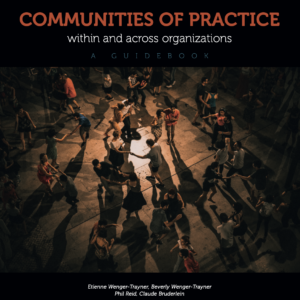NOTICE: There is an updated version of all these FAQs on our new website:
Should organizations institutionalize communities of practice?
Because of this tension between vertical and horizontal processes, integrating communities of practice in an organization is an exercise in paradox. Organizations tend to pay attention to structures or issues by institutionalizing them but it is a delicate task to integrate communities of practice into the organization without squelching the very self-organizing principle that makes them thrive. When it comes to communities of practice, organizations have varying degrees of institutionalization, which even vary from community to community. It is useful to distinguish between two kinds of institutionalization: institutionalizing communities of practice themselves, and institutionalizing their existence in the organization. Institutionalizing communities. There are cases in which institutionalizing a community makes sense. When the domain is of critical strategic importance, it may require the investment of substantial resources, including some full-time core members. Some communities include a center of excellence; some even become departments in the organization. But even when they do, it is useful to maintain a distinction between the formal center or department and the community of practice it represents. For one thing, their boundaries are likely to be distinct—some members of the community may not be part of the department, especially the more peripheral ones. And the underlying community may well have different sources of motivation, qualities of relationships, and governance expectations. The institutional part is often best understood as the core of a broader community. Institutionalizing the existence of communities. Institutionalizing a community into a formal structure requires caution; but it is always helpful to consider ways to institutionalize the existence of communities of practice in an organization—the fact that they are integral to the organization’s ability to achieve its goals. (This is true whether the relevant communities are fully inside an organization or exist across organizations.) Institutionalizing their existence can give them access to executive sponsorship and to resources, such as time, travel, and technology. Time is a good example because it is invariably a central concern for community members in organizations. Institutionalizing the existence of communities helps legitimize the time members spend on their communities without dictating what they do. Participation in communities can also be integrated in HR processes, such as developmental plans, training, and career advancement. This type of institutionalization aims to structure an explicit organizational context for communities. It does not reach into communities, nor attempt to substitute for the practitioners’ self-governance. It is a way to integrate communities by carving a special place for them in the organization, not by molding them in the image of the organization.| << What should an organization put in place? | Should participation be voluntary? >> |
For more information, click here:
For a bit more info, see our general (but brief) introduction to communities of practice and their use in various contexts:
For practical advice on cultivating communities of practice in and across organizations, see our new guidebook:
For workshops on cultivating communities of practice:

